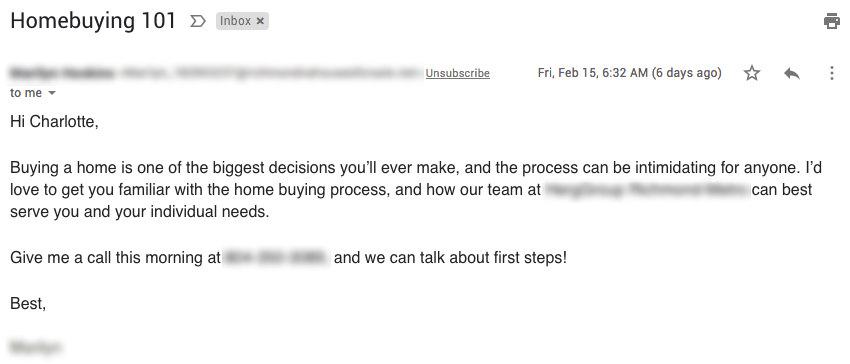The Secret to Better Email Engagement

Have you ever gotten an email and thought, “I have absolutely NO idea who this person/company is? How did I even get on their list?”
I think we’ve all been there at one time or another. We sign up for things or fill out a little form asking for our email address, and then we forget about them within seconds. Months later, we see an email from someone and wonder where in the world it came from.
In an ideal world, this would never, ever happen to anyone on your email list. And there is a very simple strategy you can apply to your email marketing that will significantly lower the chances of this happening. I’m going to give you all the details on it in this article.
But, no matter how hard we try, it WILL happen at some point; it’s unavoidable. Someone will forget how they got onto your list. The good news is our strategy for lowering the odds of them forgetting will also help you turn the most skeptical email subscriber who can’t remember you into a raving fan (and client). That’s what we call a win-win.
I recently received an email from a real estate agent, and I had this exact reaction we’re talking about here. I couldn’t remember who in the world she was, and I had absolutely no clue how I got onto her list. Zero. Zilch. Nada.
Here’s the email she sent to me.

The subject line of this email intrigued me as I do happen to be in the market to buy a house right now. And yes, buying a home is one the biggest decisions I’ll ever make and the process is intimidating (even after buying three homes previously, it’s STILL intimidating and stressful for me). And yes, I’d love some help/guidance with my individual needs.
But here’s where the email breaks down – there isn’t a snowball’s chance in Tahiti that I’m willing to pick up my phone and call this agent. Even if I did remember her and how I ended up on her list, the chances of me calling her are slim to none (and yes, before you ask, I am a recovering Millennial). But the reality is that calling her at this point in the game would be terribly uncomfortable and stressful for me. It’s far too big of a commitment to ask for at this point in our relationship.
Maybe, just maybe, if she and I had a past relationship, this would be an appropriate call to action. If we had worked together previously or if I knew her from church, then sure I might call her. If I knew her in person and not just from the Internet, maybe I’d give her a call.
But the vast majority of your emails are not being read by people you know well – they’re online leads or acquaintances. Ideally, you’re segmenting your email list so that you can give an appropriate message to your sphere of influence, past clients, etc. – the people who are more likely to be willing to call you because they know you well. But for the bulk of your database, my bet is you’ll get a 0.0000001% conversion rate on an email like this (if that).
So what do you do instead? What WILL work?
Here’s the secret: you offer value. Value, value, value. And then more value. Every single step of the way, you offer content and information that answers their questions, solves their problems, or enlightens them about things they’ve never heard of (PMI anyone?). And you offer it right there in the email, not behind the step of needing to call you.
If this agent had included a link to a home buying guide, or an infographic visualizing the impact changing interest rates will have on my ability to purchase, or a short article about why you should get pre-approved for a mortgage as your first step in the process – THEN I would have been interested in engaging with her.
Then she would have been building our relationship and creating trust with me. She would have established herself as someone who can help me, someone who can guide me through this process. She would have demonstrated her value before I had to do anything more than click a button or read an email. I wouldn’t have to put myself out there and call a stranger in order to receive the value she can provide to me and therefore recognize her as an agent who can help me.
Here’s how she could have written this email with a value-first approach.
Option 1:
Hi Charlotte,
Buying a home is one of the biggest decisions you’ll ever make, and the process can be intimidating for anyone. My goal is to help you become familiar with the home buying process, and how our team at [Company Name] can best serve you and your individual needs.
The first step in the process to consider is getting pre-approved. This shows home sellers that you are serious about buying, and it often helps speed up the process once your offer has been accepted.
I actually put together a quick article on the specifics around getting your pre-approval. Click here to take a look!
Let me know if you have any questions or would like some guidance in taking this first step. I’m also happy to connect you with one of the most experienced loan officers in town if you’re ready to get started.
Just reply to this email, I’m happy to help.
Best,
[Agent Name]
Option 2:
Hi Charlotte,
Buying a home is one of the biggest decisions you’ll ever make, and the process can be intimidating for anyone. My goal is to help you become familiar with the home buying process, and how our team at [Company Name] can best serve you and your individual needs.
The first step in the process is one of the most important, so I put together an article for you covering the basics: Buying a House This Year? This Should Be Your 1st Step!
Take a look when you have a second, and let me know if you have any questions or would like some guidance in taking this first step.
Just reply to this email, I’m happy to help.
Best,
[Agent Name]
The first option provides the basic takeaway (i.e. value) in the email itself with a link to the article for the person who wants to know more details. This one maximizes the value provided to the reader with the lowest requirement for them to actually do anything – they just have to read.
The second option vaguely teases the “first step” to intrigue the reader and encourage them to click the link. This one drives the reader to your website where you can then retarget them with Facebook ads and other communications.
And with either option, if you monitor your email engagement reports within your CRM, you can choose to follow up personally after someone clicks a link. You could shoot off a quick note asking if they found the material to be useful or if you could answer any questions about the pre-approval process for them. With the only call to action being to call you, you have no indication if the person is still interested unless they take that step to dial your number.
It’s important to note here that both options do still include some sort of call to action, just one that requires less of a commitment from the reader. They both focus on providing value first and foremost, followed by a direction of what to do next. Your emails simply cannot be a slightly longer version of “I can help you, call me!” They must provide value.
Bottom Line
When you’re setting up your email drip campaigns, sending a one off email, or creating an email newsletter, think about your audience and what they need. What questions do they have? What are they concerned about?
Think about how you can offer them the most possible value in every message. This is exactly what KCM content is designed to do – help buyers and sellers understand the things they need to consider, what’s happening in the market, why it’s happening, and what it means for them.
Leverage blog posts, buyer & seller guides, infographics, and videos to provide value to your email database and establish yourself as the agent they need to work with.




